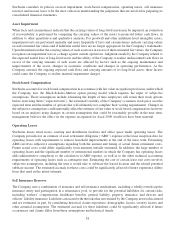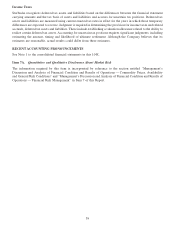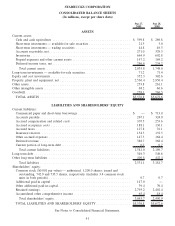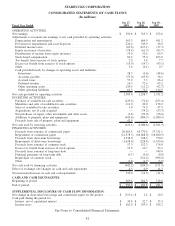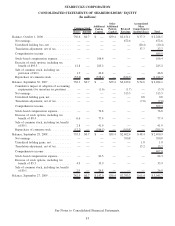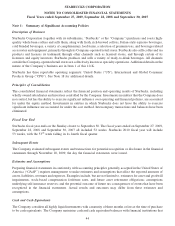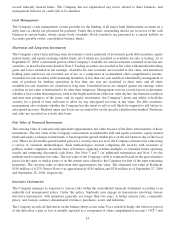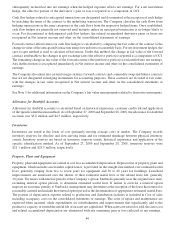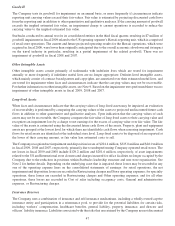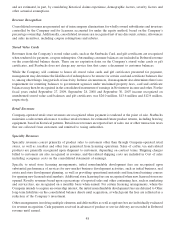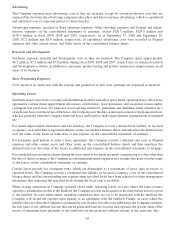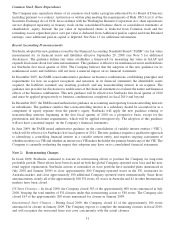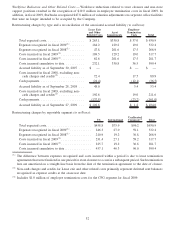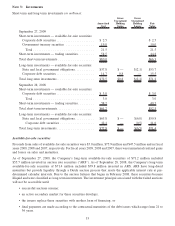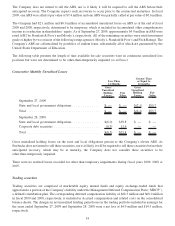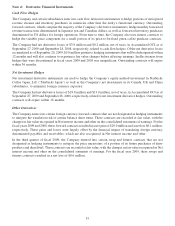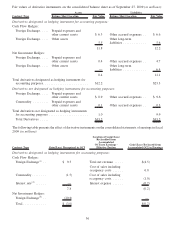Starbucks 2009 Annual Report Download - page 55
Download and view the complete annual report
Please find page 55 of the 2009 Starbucks annual report below. You can navigate through the pages in the report by either clicking on the pages listed below, or by using the keyword search tool below to find specific information within the annual report.Goodwill
The Company tests its goodwill for impairment on an annual basis, or more frequently if circumstances indicate
reporting unit carrying values exceed their fair values. Fair value is estimated by projecting discounted cash flows
from the reporting unit in addition to other quantitative and qualitative analyses. If the carrying amount of goodwill
exceeds the implied estimated fair value, an impairment charge to current operations is recorded to reduce the
carrying value to the implied estimated fair value.
Starbucks conducted its annual test for its consolidated entities in the third fiscal quarter, resulting in $7 million of
goodwill impairment in fiscal 2009 related to the US operating segment’s Hawaii reporting unit, which is comprised
of retail store operations. The current and future projected operating results for the Hawaii operations, which were
acquired in fiscal 2006, were lower than originally anticipated due to the overall economic slowdown and its impact
on the travel industry in particular, resulting in a partial impairment of the related goodwill. There was no
impairment of goodwill in fiscal 2008 and 2007.
Other Intangible Assets
Other intangible assets consist primarily of trademarks with indefinite lives which are tested for impairment
annually or more frequently if indefinite useful lives are no longer appropriate. Definite-lived intangible assets,
which mainly consist of contract-based patents and copyrights, are amortized over their estimated useful lives, and
are tested for impairment when facts and circumstances indicate that the carrying values may not be recoverable.
For further information on other intangible assets, see Note 9. Based on the impairment tests performed there was no
impairment of other intangible assets in fiscal 2009, 2008 and 2007.
Long-lived Assets
When facts and circumstances indicate that the carrying values of long-lived assets may be impaired, an evaluation
of recoverability is performed by comparing the carrying values of the assets to projected undiscounted future cash
flows in addition to other quantitative and qualitative analyses. Upon indication that the carrying values of such
assets may not be recoverable, the Company compares the fair value of long-lived assets to their carrying value and
recognizes an impairment loss by a charge to net earnings for the excess of carrying value over fair value. The fair
value of the assets is estimated using the discounted future cash flows of the assets. Property, plant and equipment
assets are grouped at the lowest level for which there are identifiable cash flows when assessing impairment. Cash
flows for retail assets are identified at the individual store level. Long-lived assets to be disposed of are reported at
the lower of their carrying amount, or fair value less estimated costs to sell.
The Company recognized net impairment and disposition losses of $224.4 million, $325.0 million and $26.0 million
in fiscal 2009, 2008 and 2007, respectively, primarily due to underperforming Company-operated retail stores. The
net losses in fiscal 2009 and 2008 include $129.2 million and $201.6 million, respectively, of asset impairments
related to the US and International store closures and charges incurred for office facilities no longer occupied by the
Company due to the reduction in positions within Starbucks leadership structure and non-store organization. See
Note 2 for further details. Depending on the underlying asset that is impaired, these losses may be recorded in any
one of the operating expense lines on the consolidated statements of earnings: for retail operations, the net
impairment and disposition losses are recorded in Restructuring charges and Store operating expenses; for specialty
operations, these losses are recorded in Restructuring charges and Other operating expenses; and for all other
operations, these losses are recorded in Cost of sales including occupancy costs, General and administrative
expenses, or Restructuring charges.
Insurance Reserves
The Company uses a combination of insurance and self-insurance mechanisms, including a wholly owned captive
insurance entity and participation in a reinsurance pool, to provide for the potential liabilities for certain risks,
including workers’ compensation, healthcare benefits, general liability, property insurance, and director and
officers’liability insurance. Liabilities associated with the risks that are retained by the Company are not discounted
47



